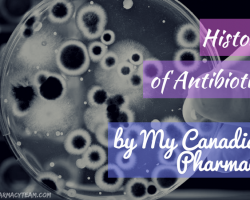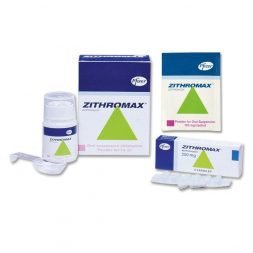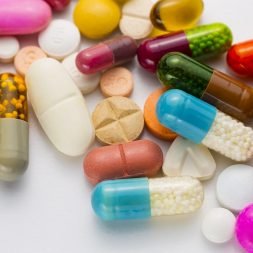In recent decades, medical practice has been enriched by a new group of biological products for infectious diseases treatment and prevention and was defined as «antibiotics».
Ability of some microorganisms to suppress lives of others (antibiosis) was first established by I. I. Mechnikov, who proposed use of this property for therapeutic purposes: in particular, he used lactobacillus to suppress vital functions of harmful putrefaction bacteria in intestine, which was offered to introduce with clabber.
In 1868 – 1871 V. A. Manassein and A. G. Polotebnov pointed to green mold ability to inhibit growth of a variety of pathogenic bacteria, and successfully applied it for infected wounds and ulcers treatment.
Great importance in studies about antibiotics had researches of N. A. Krasilnikov, A. I. Korenyako, M. I. Nakhimovskaya and D. M. Novogrudskiy, which established wide fungi enlargement in soil that produce different antibiotic substances, that now have a broad classification with various subclasses and types.

In 1940, there were created methods of curing and obtention of antibiotic substances from culture fluid in pure form. Many of these antibiotic substances have proven to be very effective in treating a variety of infectious diseases.
The greatest value in medical practice has the following list of antibiotics:
- penicillin;
- streptomycin;
- laevomycetin;
- synthomycin;
- tetracyclines;
- albomycin;
- gramicidin C;
- micerinum, etc.
Currently, chemical nature of many antibiotics is known, which allows to obtain these antibiotics not only from natural products, but also by synthesis.
My Canadian Pharmacy antibiotics, possessing ability to inhibit development of pathogenic bacteria in the body, at the same time have low toxicity to human body. By inhibiting development of pathogenic microbes in the body, they thereby contribute to body protective properties strengthening and rapid recovery of patients. That’s why correct choice of antibiotic for treatment of various infectious diseases is necessary. In some cases, it is possible to use a combination of antibiotics or carry out comprehensive treatment with antibiotics, sulfonamides and other drugs.
Penicillin
Penicillin is a substance produced by Penicillium mold with its growth in liquid nutrient media. It was first produced by British scientist Alexander Fleming in 1928. In the USSR penicillin was obtained by Z. V. Yermolyeva in 1942. For obtaining penicillin the mold is inoculated in special nutrient medium, where penicillin accumulated as it is breeding. Optimal temperature for Penicillium growth is 24 – 26 °C. Maximal accumulation of penicillin occurs in 5 – 6 days, and at intense supply of oxygen (aeration) – more quickly. Nutritional liquid is filtered and subjected to special processing and chemical clearance. The resulting purified preparation is obtained as crystalline powder. Liquid form of penicillin is unstable, powder is more stable, especially at temperature of 4 – 10 °C. Powder is quickly and completely dissolved in distilled water or saline solution.
Penicillin has ability to inhibit reproduction of many pathogenic microbes in the body – staphylococci, streptococci, gonococci, anaerobic bacilli, spirochetes of syphilis. Penicillin doesn’t affect typhoid fever bacillus, dysentery, Brucella, tuberculosis bacillus. Penicillin is widely used for treatment of suppurative processes, septic diseases, pneumonia, gonorrhea, cerebrospinal meningitis, syphilis, anaerobic infections.
Unlike most synthetic chemical preparations penicillin is low-toxic to humans and can be administered in large doses. Usually penicillin is introduced intramuscularly, since administered orally it is rapidly dissolved by gastric intestinal juice.
In the body, penicillin is rapidly excreted by kidneys, therefore it is administered intramuscularly every 3 – 4 hours. Penicillin amount is calculated in unit of activity (UA). One unit of penicillin is considered amount, that is completely inhibits growth of Staphylococcus aureus in 50 ml of broth.
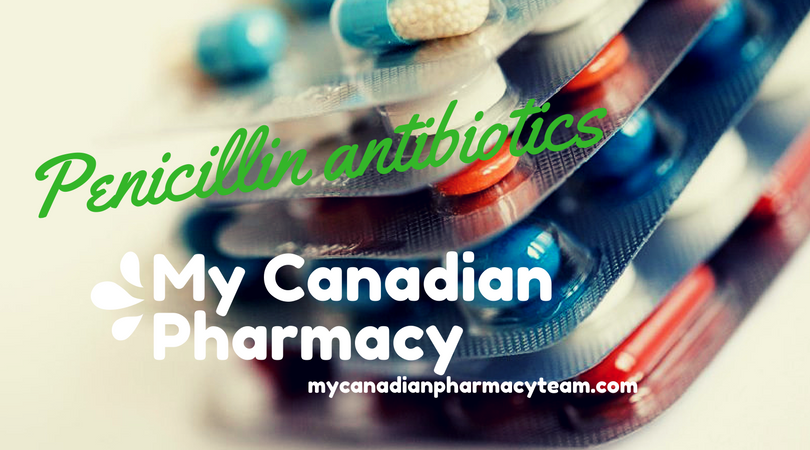
To extend period of penicillin action in the body, there was created a number of new products containing penicillin in combination with other substances that contribute to slow penicillin absorption and even slower clearance from the body by kidneys. Some of these drugs can be taken orally because they are not destroyed by gastric and intestinal juice. Such drugs include, for example, phenoxymethylpenicillin; the latter is available in pills for oral administration.
Currently, there was received a large group of new penicillin drugs – semisynthetic penicillins. These drugs are based on 6-amino-penicillic acid, included in penicillin nucleus, to which various chemical radicals are attached. New penicillins (methicillin, oxacillin, etc.) act on microorganisms resistant to benzylpenicillin.
The largest number of antibiotics is produced by ray fungi – actinomycetes. Among these antibiotics streptomycin, chloromycetin (laevomycetin), biomycin (aureomycin) terramycin, tetracycline, colimycine, mycerinum and others.
Streptomycin
Streptomycin is a substance produced by Actinomyces globisporus streptomycin ray fungus. It has ability to inhibit growth of many gram-negative and gram-positive bacteria, as well as tuberculosis bacillus. Streptomycin disadvantage is that germs quickly get used to it and become resistant to its action. Action efficiency of streptomycin is tested on E. coli (Bact. Coli). Practical application streptomycin found in certain forms of tuberculosis treatment, especially tuberculous meningitis, tularemia, as well as in surgical practice.
Chloromycetin
Chloromycetin was obtained in 1947, from actinomycetes culture broth. In 1949 scientists had synthesized similar drug called laevomycetin. Laevomycetin is a crystalline powder, very stable in dry state and in solution. Laevomycetin solutions are boiled during 5 hours. Laevomycetin is active against many gram-positive and gram-negative bacteria, as well as rickettsiae. Laevomycetin is taken orally. Laevomycetin is recommended for treatment of the following diseases: typhoid and paratyphoid fever, typhus fever, brucellosis, whooping cough, dysentery and surgical infections caused by gram-negative bacteria.
Along with laevomycetin another synthetic drug is widely used – synthomycin, which is a unpurified laevomycetin. By its action synthomycin is similar to laevomycetin; it is administered at dosage 2 times greater than that of laevomycetin.
Tetracyclines
They include chlortetracycline (aureomycin, biomycin), oxytetracycline (terramycin) and tetracycline. Chlortetracycline is obtained from Actinomyces aureofaciens fungus culture liquid, it has broad spectrum of action against most gram-positive and gram-negative bacteria, protozoa, rickettsiae and some large viruses (ornithosis), is well absorbed when administered orally and diffuses into tissues. It is used to treat dysentery, brucellosis, rickettsial diseases, syphilis, psittacosis and other infectious diseases. Oxytetracycline and tetracycline in their properties resemble chlortetracycline and are close to it in mechanism of action on microbe.
Neomycins
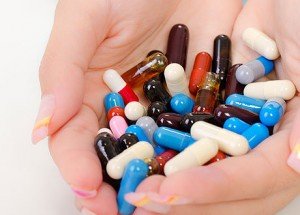 Neomycins are a group of antibiotics derived from culture fluid of actinomycetes, active against many gram-negative and gram-positive bacteria, including mycobacteria. Their activity is not reduced in presence of blood proteins or enzymes. Drugs are poorly absorbed in gastrointestinal tract, relatively low-toxic. They are used mainly for local treatment of surgical and skin infections caused by staphylococci showing resistance to other antibiotics.
Neomycins are a group of antibiotics derived from culture fluid of actinomycetes, active against many gram-negative and gram-positive bacteria, including mycobacteria. Their activity is not reduced in presence of blood proteins or enzymes. Drugs are poorly absorbed in gastrointestinal tract, relatively low-toxic. They are used mainly for local treatment of surgical and skin infections caused by staphylococci showing resistance to other antibiotics.
Neomicins group include mycerinum and colimycine, which are widely used for colienteritis treatment in children, caused by Escherichia coli or staphylococci resistant to other antibiotics.
Nistatine
Nistatine is an antibiotic, effective not against bacteria but against fungi. It is poorly dissolves in water, so it can not be used parenterally, but must be administered orally in the form of pills or locally as ointments.
Nistatine is often included in pills together with another antibiotic – tetracycline – to prevent candidiasis as complications after prolonged tetracycline use.
Among My Canadian Pharmacy antibiotics of bacterial origin gramicidin is more important.
Gramicidin
Gramicidin is a substance derived from culture of soil B. brevis spore bacillus. Medication got its name due to the fact that it mainly inhibits growth of gram-positive bacteria. In 1942 scientists discovered antibiotic called gramicidin S. It possesses a broad range of action, inhibiting growth of bacteria. Gramicidin S is used in the form of water-alcohol, alcohol and oily solutions only for local treatment of suppurative and ulcerous processes.
Antibiotics of animal origin are also of great interest.
In 1887 N. F. Gamaleia pointed to antibacterial action of animal tissues. Then, in 1893 O. O. Uspensky demonstrated bactericidal activity of liver extracts against anthrax bacillus, equinia, staphylococcus and other germs.
From antibiotics of animal origin the following names got widespread use:
- Lysozyme is a substance produced by animal and human cells. First discovered by P. N. Laschenkov in 1909 in albumen. Lysozyme is found in tears, mucous secretions, in liver, spleen, kidneys, serum. It has ability to dissolve both living and dead microbes. Purified lysozyme was applied by Z. V. Yermolyeva and J. S. Buyanovskaya in clinical, industrial and agricultural practices. There is effect of using lysozyme at diseases of ears, throat, nose and eyes, at post-influenza complications.
- Ecmolin is derived from fish tissue, biologically active against typhoid and dysentery bacillus, staphylococcus and streptococcus, also affects influenza virus. Ecmolin enhances penicillin and streptomycin action. Scientists report about positive results of complex application of ecmolin with streptomycin for acute and chronic dysentery treatment and ecmolin with penicillin – for treatment and prevention of cocci infections.
- Phytoncids are substances produced by plants. Discovered by Soviet scholar B. P. Tokin in 1928. These substances have antimicrobial effect on many microorganisms, including protozoa. The most actively phytoncids are produced by onions and garlic. If to chew onion for a few minutes, mouth is rapidly cleared from germs. Phytoncids are used for local treatment of infected wounds. Antibiotics have received very wide application in medical practice and contributed to sharp reduction in number of deaths from various infectious diseases (suppurative processes, meningitis, anaerobic infection, typhoid and typhus fever, tuberculosis, child infections and others).
However, it is necessary to specify some unwanted side effects of antibiotics and their impact.
In case of improper use of antibiotics (small dosage, short-term treatment) resistant to this antibiotic forms of pathogens may appear. As a result, for medical practice it is very important to determine sensitivity of infectious disease pathogen to one or another antibiotic.
There are 2 ways to determine sensitivity of microbes to antibiotics:
- method of serial dilutions;
- diffusion method.
The first method is more complicated and is as follows: in test tubes with 2 ml of broth multiple dilutions of antibiotic are added, then each tube is inoculated with 0,2 ml of broth culture of test microbe; tubes are placed in incubator for 16 – 18 hours. The last tube with no microbial growth determines degree of microbe sensitivity to antibiotic.
A simpler method is diffusion method. For this purpose, laboratories have special set of disks of blotting paper, saturated with solutions of different antibiotics. Inoculation of the culture is carried out in a Petri dish with meat infusion agar. These discs are put on inoculated surface.
Dishes are placed in incubator for 24 – 48 hours after which result is recorded.
Other complications of Canadian Pharmacy antibiotics use include decrease of immunological reactivity. In this case, sometimes such relapses occur as typhoid fever.
Too long reception of antibiotics and high doses frequently cause toxic effects. At some patients one or another antibiotic causes allergic reaction in the form of skin rash, vomiting and so on.

In some cases, as a result of prolonged use of biomycin, laevomycetin, synthomycin, inhibition of normal human microflora is possible, which leads activation of conditionally pathogenic microbes that live in mucous membranes of mouth or intestines: Enterococcus, yeast-like organisms, etc. This flora in weakened body can cause disease of different nature (candidiasis, etc.). All this proves the fact that health care workers should use Canadian Pharmacy antibiotics, strictly guided by existing guidelines and instructions, observing carefully patient’s condition, and if necessary interrupt treatment with antibiotics or replace the drug. Patients should take antibiotics strictly on doctors prescription, not trying to obtain antibiotics over the counter and engaging in self-medication.
These complications do not reduce value of antibiotics as therapeutic drug. Due to antibiotics health care workers currently have specific remedies for treatment of most infectious diseases.
Posted by Dr. Himanshu Singh

 English
English Deutsch
Deutsch Français
Français Italiano
Italiano Español
Español Svenska
Svenska Português
Português 日本人
日本人 Dansk
Dansk Norsk
Norsk Suomi
Suomi Czech
Czech